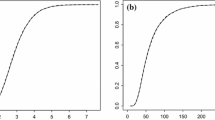Abstract
The misclassification process is represented by a stochastic matrix containing the probabilities that an individual who belongs in one cell is counted as belonging to another (or perhaps the same) cell. These probabilities are supposed known. If misclassification in the row direction is independent of that along the column variable then the size of the usual chi-square test is unchanged. It is shown how to calculate loss of power in this case and also how to calculate the change in size of the test if the errors are not independent. A modified test criterion is suggested when errors are not independent and a numerical example is included.
Similar content being viewed by others
References
Assakul, K. Testing hypotheses with categorical data subject to misclassification. Mimeo. Series No. 448, Institute of Statistics, Raleigh, N. C., 1965.
Barnard, G. A. Significance tests for 2 × 2 tables.Biometrika, 1947,34, 248–252.
Bross, I. Misclassification in 2 × 2 tables.Biometrics, 1954,10, 478–486.
Cramer, H.Mathematical methods of statistics. Princeton: Princeton University Press, 1946.
Diamond, E. L. The limiting power of categorical data chi-square tests analogous to normal analysis of variance.Ann. Math. Stat., 1963,34, 1432–1441.
Fix, E. Tables of non-centralx 2.Univ. Calif. Publication in Statistics, 1949,1, 15–19.
Mitra, S. K. On the limiting power function of the frequency chi-square test.Ann. Math. Stat., 1958,29, 1221–1233.
Mote, V. L. and Anderson, R. L. The effect of misclassification on the properties ofx 2-tests.Biometrika, 1965,52, 95–109.
Neyman, J. Contributions to the theory of thex 2-tests. In theProceedings of the Berkeley Symposium on Mathematical Statistics and Probability. University of California Press, 1949.
Pitman, E. J. G. Notes on non-parametric statistical inference. Mimeo. Series No. 27, Institute of Statistics, Raleigh, N. C., 1948.
Roy, S. N. and Mitra, S. K. An introduction to some non-parametric generalizations of analysis of variance and multivariate analysis. Mimeo. Series No. 139, Institute of Statistics, Raleigh, N. C., 1955.
U. S. Bureau of Census.Evaluation and Research Program of the U. S. Censuses of Population and Housing, 1960—Accuracy of Data on Housing Characteristics. Series ER60, No. 3, Washington, D. C., 1964.
U. S. Bureau of the Census.U. S. Census of Housing: 1960. Washington, D. C., 1963, VI.
Author information
Authors and Affiliations
Rights and permissions
About this article
Cite this article
Assakul, K., Proctor, C.H. Testing independence in two-way contingency tables with data subject to misclassification. Psychometrika 32, 67–76 (1967). https://doi.org/10.1007/BF02289405
Received:
Revised:
Issue Date:
DOI: https://doi.org/10.1007/BF02289405




